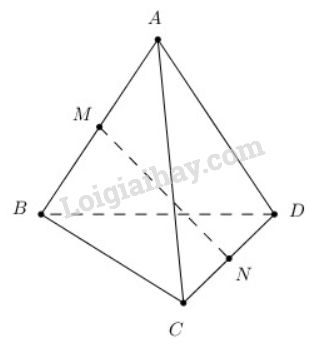 Giải toán 11, giải bài tập toán lớp 11 đầy đủ đại số và giải tích, hình học
Giải toán 11, giải bài tập toán lớp 11 đầy đủ đại số và giải tích, hình học
 Bài 2. Hai đường thẳng vuông góc
Bài 2. Hai đường thẳng vuông góc
Bài 8 trang 98 SGK Hình học 11
Cho tứ diện ABCD có AB = AC = AD ...
Đề bài
Cho tứ diện \(ABCD\) có \(AB = AC = AD\) và \(\widehat{BAC}=\widehat{BAD}=60^{0}.\) Chứng minh rằng:
a) \(AB ⊥ CD\);
b) Nếu \(M, N\) lần lượt là trung điểm của \(AB\) và \(CD\) thì \(MN ⊥ AB\) và \(MN ⊥ CD\).
Video hướng dẫn giải
Lời giải chi tiết

a) \(\overrightarrow{AB}.\overrightarrow{CD}=\overrightarrow{AB}(\overrightarrow{AD}-\overrightarrow{AC})\)
\(=\overrightarrow{AB}.\overrightarrow{AD}-\overrightarrow{AB}.\overrightarrow{AC}\)
\(=AB.AD.\cos\widehat{BAD}-AB.AC.\cos\widehat{BAC} =0\)
Cộng (1) với (2) theo vế với vế ta được:
\(\begin{array}{l}
2\overrightarrow {MN} \\
= \left( {\overrightarrow {MA} + \overrightarrow {MB} } \right) + \left( {\overrightarrow {AD} + \overrightarrow {BC} } \right) + \left( {\overrightarrow {DN} + \overrightarrow {CN} } \right)\\
= \overrightarrow 0 + \left( {\overrightarrow {AD} + \overrightarrow {BC} } \right) + \overrightarrow 0 \\
= \overrightarrow {AD} + \overrightarrow {BC} \\
\Rightarrow \overrightarrow {MN} = \dfrac{1}{2}\left( {\overrightarrow {AD} + \overrightarrow {BC} } \right)\\
= \dfrac{1}{2}\left( {\overrightarrow {AD} + \overrightarrow {AC} - \overrightarrow {AB} } \right)
\end{array}\)
Ta có \(\overrightarrow{AB}.\overrightarrow{MN}={1 \over 2}\overrightarrow {AB} .(\overrightarrow {AD} + \overrightarrow {AC} - \overrightarrow {AB} )\)
\(= {1 \over 2}(\overrightarrow {AB} .\overrightarrow {AD} + \overrightarrow {AB} .\overrightarrow {AC} - A{B^2})\)
\(= {1 \over 2}(AB.AD.\cos\widehat{BAD}+AB.AC.\cos\widehat{BAC}-AB^2)\)
\(={1 \over 2}(AB.AD.\cos60^0+AB.AC.\cos60^0-AB^2)\)
\(={1 \over 2}\left({1 \over 2}AB^2+{1 \over 2}AB^2-AB^2\right)=0\) \(\Rightarrow AB ⊥ MN\).
\(\begin{array}{l}
\overrightarrow {MN} .\overrightarrow {CD} \\
= \dfrac{1}{2}\left( {\overrightarrow {AD} + \overrightarrow {AC} - \overrightarrow {AB} } \right).\left( {\overrightarrow {AD} - \overrightarrow {AC} } \right)\\
= \dfrac{1}{2}\left( {{{\overrightarrow {AD} }^2} + \overrightarrow {AC} .\overrightarrow {AD} - \overrightarrow {AB} .\overrightarrow {AD} - \overrightarrow {AC} .\overrightarrow {AD} - {{\overrightarrow {AC} }^2} + \overrightarrow {AB} .\overrightarrow {AC} } \right)\\
= \dfrac{1}{2}\left( {A{D^2} - \overrightarrow {AB} .\overrightarrow {AD} - A{C^2} + \overrightarrow {AB} .\overrightarrow {AC} } \right)\\
= \dfrac{1}{2}\left( {A{D^2} - AB.AC\cos \widehat {BAD} - A{C^2} + AB.AC.\cos \widehat {BAC}} \right)\\
= \dfrac{1}{2}\left( {A{B^2} - A{B^2}\cos {{60}^0} - A{B^2} + A{B^2}\cos {{60}^0}} \right)\\
= \dfrac{1}{2}.0 = 0\\
\Rightarrow MN \bot CD
\end{array}\)
Loigiaihay.com











